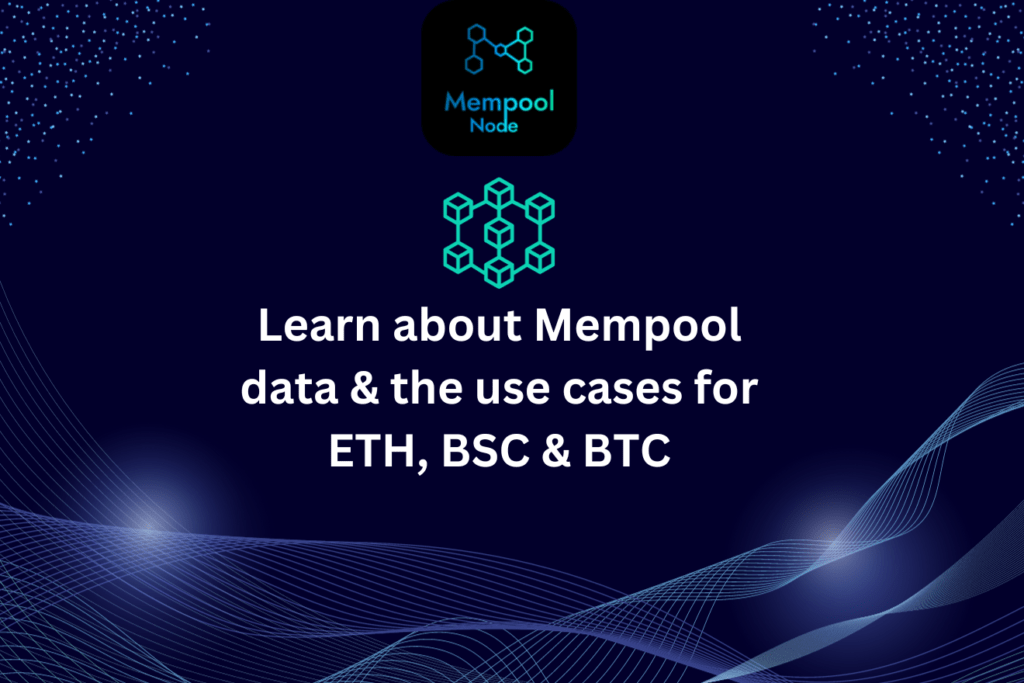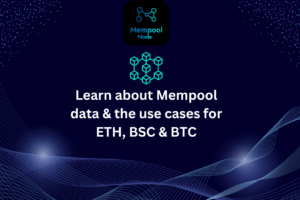What is Mempool data?
Mempool data is a collection of transactions that are waiting to be included in a block on a blockchain networks, such as; Ethereum, Binance Smart Chain, Bitcoin and more. This data has proven a valuable resource for DeFi users, MEV traders, and DEX users, seeking profitable opportunities.
How is Mempool Data Used in DeFi?
Mempool data can be used in DeFi for a variety of purposes, including:
-
- Frontrunning: Frontrunning is a technique used by MEV traders to profit by submitting transactions ahead of others. By using mempool data, MEV traders can see which transactions are likely to be included in the next block, and they can submit their own transactions ahead of those transactions. This can be used to exploit arbitrage opportunities, such as buying an asset on one DeFi protocol and selling it on another DeFi protocol at a higher price.
-
- Arbitrage: Arbitrage is the practice of buying an asset in one market and selling it in another market for a profit. By using mempool data, DeFi users can identify arbitrage opportunities between different DeFi protocols, such as Aave, Compound, and Uniswap.
-
- Liquidity mining: Liquidity mining is a process by which users can earn rewards for providing liquidity to a DeFi protocol. By using mempool data, DeFi users can identify liquidity mining opportunities that are likely to be profitable. This can be done by monitoring the mempool for transactions that are likely to be included in the next block and then submitting transactions that will benefit from those transactions.
How is Mempool Data Used in DEXs?
DEXs are decentralized exchanges that allow users to trade cryptocurrencies without the need for a centralized intermediary. Mempool data can be used in DEXs for a variety of purposes, including:
-
- Price discovery: Mempool data can be used to help DEXs determine the fair price of an asset. This is because mempool data shows the prices that users are willing to pay for an asset.
-
- Risk management: Mempool data can be used to help DEXs manage risk. For example, mempool data can be used to identify transactions that are likely to fail, which can help DEXs to avoid losses.
-
- Fraud detection: Mempool data can be used to help DEXs detect fraud. For example, mempool data can be used to identify transactions that are likely to be wash trades, which are fraudulent transactions that are designed to manipulate the price of an asset.
Do You Need Mempool Data Services?
If you are a DeFi user, MEV trader, or DEX user, then you need mempool data services. Mempool data services provide you with access to real-time mempool data, which you can use to profit from the activity on the Ethereum blockchain and Binance Smart Chain.
How to Choose the Right Mempool Data Provider
There are a number of different mempool data providers available, so it is important to choose the right one for your needs. When choosing a mempool data provider, you should consider the following factors:
- Reliability: The mempool data provider should be reliable and provide accurate data.
- Speed: The mempool data provider should provide real-time data.
- Pricing: The mempool data provider should offer competitive pricing.
- Support: The mempool data provider should offer good customer support.
How to Use Mempool Data to Your Advantage
Once you have chosen a mempool data provider, you can start using mempool data to your advantage. Here are a few tips:
- Monitor the mempool for profitable opportunities: Use mempool data to monitor the activity on the Ethereum blockchain and Binance Smart Chain and identify profitable opportunities, such as frontrunning and arbitrage.
- Stay up-to-date on the latest developments: The Ethereum blockchain and Binance Smart Chain are constantly evolving, so it is important to stay up-to-date on the latest developments. This will help you to identify new opportunities and avoid risks.
- Use a variety of tools: There are a number of different tools available that can help you to use mempool data. Use a variety of tools to get the most out of your data.
- Consider using a mempool data provider that offers mempool data for both Ethereum and Binance Smart Chain: This will give you the flexibility to trade



